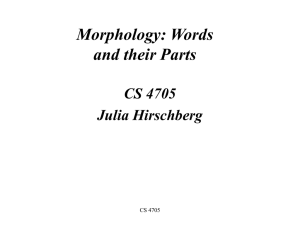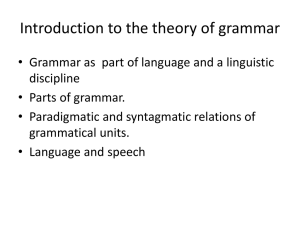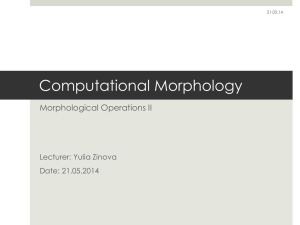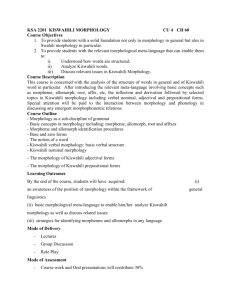Words and Rules
advertisement
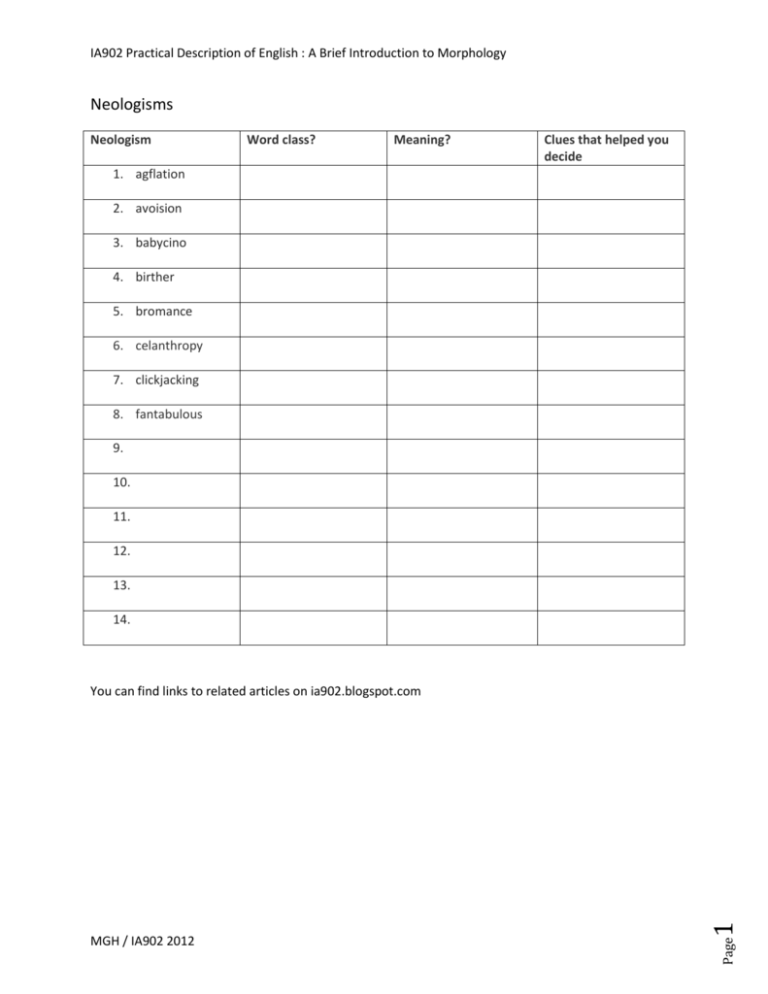
IA902 Practical Description of English : A Brief Introduction to Morphology Neologisms Neologism Word class? Meaning? Clues that helped you decide 1. agflation 2. avoision 3. babycino 4. birther 5. bromance 6. celanthropy 7. clickjacking 8. fantabulous 9. 10. 11. 12. 13. 14. Page MGH / IA902 2012 1 You can find links to related articles on ia902.blogspot.com IA902 Practical Description of English : A Brief Introduction to Morphology What is morphology? A feline exploration From Collins Cobuild Essential English Dictionary (1998): cat cats catcall catty cattier cattiest And what about: catlike, catfish, catnap, catnip, catwalk Or: cat’s eyes, cat food, catkin, cat-o-nine-tails Or even: a game of cat and mouse How can we define a word? 1. Do the hyphens in cat-o-nine-tails make it just one word? 2. Some people might write “cat food” as two words, some as one? Who’s right? 3. In spoken English, in the statement “we’ve run out of cat food”, will we hear a boundary between “cat” and “food”? What about when “cat food” appears in an exchange like “No, not dog food. I need cat food!”? Should this affect its status? 4. Would it help a learner to think of “a game of cat and mouse” as one word? Page MGH / IA902 2012 2 5. What do you think of Katamba’s definition of words as “the smallest unit that syntax manipulates”? IA902 Practical Description of English : A Brief Introduction to Morphology Page MGH / IA902 2012 3 From Steven Pinker’s Words and Rules IA902 Practical Description of English : A Brief Introduction to Morphology Morphology: the study of word structure Definitions of morphemes: Morphemes are the smallest unit of meaning in written English (Katamba and Stonham, 2005). Page MGH / IA902 2012 4 A morpheme is “that part of a word which is endowed with psychological autonomy and is for the very same reason not further divisible” (in Aronoff, 1994). IA902 Practical Description of English : A Brief Introduction to Morphology Morphology and phonology Plural nouns 1. What allomorphs are used in English to make nouns plural? 2. How are the mophs –s and –es pronounced? Consider the following plural nouns, taken from Culpepper et al (2009): bees dogs cribs ways buns bells buses judges foxes badges watches mazes socks bits steps proofs paths myths Verbs 1. In English verbs, what are the roles of the morph –ed? 2. How many different ways is –ed pronounced? Affixes and word stress 1. Where’s the stress in semi-circle, personality, refugee, mountaineer, Portuguese, cigarette, picturesque? 2. Where’s the stress in unpleasant, marketing, comfortable, anchorage, refusal, widen, wonderful, birdlike, powerless, hurriedly, punishment, happiness, poisonous, glorify, otherwise, funny, childish, demolish? Page MGH / IA902 2012 5 3. Where’s the stress in magnet and magnetic, advantage and advantageous, photograph and photography, proverb and proverbial, climate and climatic, perfect and perfection, injury and injurious, tranquil and tranquillity, reflex and reflexive? IA902 Practical Description of English : A Brief Introduction to Morphology Difficulties for the learner from Thornbury, S. 2005 Uncovering Grammar : How to Help Grammar Emerge. MacMillan, p.18: One researcher, for example, found that learners pass through a stage when they tend to attach the ending –ing to action verbs, irrespective of tense. They seem to be using –ing simply to mark the presence of a verb: I going work by bus; I eating every day Burger King, etc. Clumsy as this may seem, it marks an important step from using purely lexical means to using more grammatical ones. At first the -ing ending is applied indiscriminately to all verbs. But over time, the learners in the study started to restrict the use of –ing to certain contexts, and mainly as a marker of ‘pastness’: Yesterday I no working. Other favoured contexts for –ing were in subordinate clauses (He the man who I talking him) and verbal complements, ie constructions where one verb follows another, eg I want working and I can doing any job. Why –ing? The researcher hypothesized that, of all the possible word endings in English, -ing is the most easily identified: it is a whole syllable and it is phonetically simple and regular. As grammaring processes start to emerge, -ing is a convenient tool for flagging ‘verbiness’, or, more specifically, ‘action’. At first, all verbs are flagged. Then the learner starts to discriminate between varying degrees of distance: present and past. The later use of –ing in the more relatively specialised contexts of pastness, subordinate clauses and verbal complements suggests learners are aware of the more grammaticized nature of these contexts and nee dto flag them accordingly. Not yet aware of how these specialized meanings are signalled, they use the all purpose –ing, as if to say “here be grammar”. 1. Does the phenomenon presented by Thornbury here seem familiar in relation to students that you have taught? 2. Is Thornbury’s argument well-supported in the extract above? Compositionality In morphology, we can work out the meaning of words we haven’t met before. However, we need to be careful. What’s the meaning of the following words: - Seeker, writer, driver, cooker, looker? Noncompositional words are therefore problematic. Consider the unfortunate wording of this sign in a Chinese hotel: The lift is being fixed for next day. During that time we regret that you will be unbearable. Conversion Page MGH / IA902 2012 6 Because conversion is common in English (nouns become verbs and vice versa), syntactic make-up may not reflect syntactic category, e.g. hoover, upmarket IA902 Practical Description of English : A Brief Introduction to Morphology Difficulties for the teacher Below are examples from essays by international students in response to a question about the differences between choosing a subject for undergraduate study, and choosing a subject for postgraduate study: 1. An interest subject give them more power to improve themselves. 2. Some of us think “no interest, no power”, which means they can’t study hard in a no-interesting major. 3. Some people have responsibilities to socialty. 4. It may not be too much to say that postgraduate students’ purposes are job. 5. A lot of prospective undergraduate students may tend to be based on their own interests to think about their studying fields. 6. The following example will be clear this. 7. That is a common phenomena for the Chinese student, when they are in an important timepoint in their life. 8. A subject field for undergraduate study provides easily opportunities for people to get well-paid jobs. 9. For the postgraduate students, no thing can’t more important than their interesting for the subject. 10. Some parents believe that if their relatives have a well-educated and a good career job, they probably want to this case for their children. Page MGH / IA902 2012 7 To what extent can analysis of morphological features of English help these students? IA902 Practical Description of English : A Brief Introduction to Morphology Difficulties for everyone! Which is the correct plural form? Option 1 Option 2 cowboys cowsboy cowgirls cowsgirl breakfasts breaksfast christmases christsmas businesses busiesness girl from Ipanemas girls from Ipanema mother-in-laws mothers-in-law gin and tonics gins and tonic tablespoonfuls tablespoonsful work of arts works of art hole in ones holes in one passerbys passersby governor-generals governors-general POWs POW Preference? irrational irrevocable irregular improper impure impartial imprudent impartial unlovable unlikable unrealistic unruly unrenewable unpopular unparalleled MGH / IA902 2012 Page illogical illegal illicit 8 Can phonology help us to explain the morphological features of English at work in these examples? IA902 Practical Description of English : A Brief Introduction to Morphology References Aronoff, M. 1994 Morphology by itself: Stems and Inflectional Classes. MIT Press Culpeper, J. et al (eds) 2009 English Language: Description, Variation and Context. Palgrave Macmillan Halliday, M.A.K. and Greaves, W.S. 2008 Intonation in the Grammar of English. Equinox Katamba, F. 2005 English Words. 2nd Edn. Routledge. Katamba, F. and Stonham, J. 2005 Morphology. 2nd Edn. Palgrave Macmillan Pinker, S. 1999 Words and Rules. Phoenix Roach, P. 2009 English Phonetics and Phonology : A Practical Course. 4th Edn. Cambridge University Press Thornbury, S. 2005 Uncovering Grammar : How to Help Grammar Emerge. Macmillan Further reading Ilson, R. 1983 “Etymological information: can it help our students?” ELT Journal 37/1 Page MGH / IA902 2012 9 Pierson, H. D. 1989 “Using etymology in the classroom”. ELT Journal 43/1





